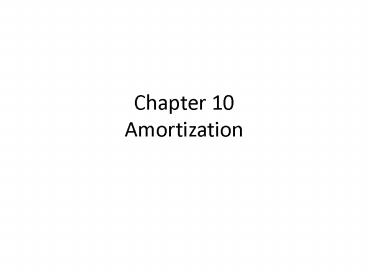Chapter 10 Amortization PowerPoint PPT Presentation
1 / 19
Title: Chapter 10 Amortization
1
Chapter 10Amortization
2
FACTORS IN CALCULATING AMORTIZATION
Illustration 10-6
3
AMORTIZATION METHODS
- Three methods of recognizing amortization are
1. Straight-line, 2. Units of activity, and
3. Declining-balance. Each method is
acceptable under generally accepted accounting
principles. Management selects the method that
is appropriate for their company. Once a method
is chosen, it should be applied consistently.
4
STRAIGHT-LINE METHOD
5
STRAIGHT-LINE METHOD
- Amortization is constant for each year of the
asset's useful life
6
DECLINING-BALANCE METHOD
- The calculation of periodic amortization is based
on a declining net book value (cost less
accumulated amortization) of the asset. - The amortization rate remains constant from year
to year, but the net book value to which the rate
is applied declines each year.
7
DECLINING-BALANCE METHOD
- Accelerated methods result in more amortization
in early years and less in later years
8
UNITS-OF-ACTIVITY METHOD
- To use the units-of-activity method,
- 1) the total units of activity for the entire
useful life are estimated, - 2) the amount is divided into amortizable cost
to calculate the amortization cost per unit, and - 3) the amortization cost per unit is then
applied to the units of activity during the year
to calculate the annual amortization.
9
UNITS-OF-ACTIVITY METHOD
- Useful life is expressed in terms of total units
of production or activity expected from the asset
10
REVISING PERIODIC AMORTIZATION
- If annual amortization is inadequate or
excessive, a change in the periodic amount should
be made. - When a change is made,
- 1. there is no correction of previously
recorded amortization expense and - 2. amortization expense for current and
future years is revised.
Revised amortization expense Net book value at
time of revision revised salvage
value Remaining useful life
11
EXPENDITURES DURING USEFUL LIFE
- Ordinary repairs are expenditures to maintain
the operating efficiency and expected
productive life of the capital asset. - They are debited to Repairs Expense as incurred
and are often referred to as operating
expenditures. - Additions and improvements are costs incurred to
increase the operating efficiency,
productive capacity, or expected
useful life of the capital asset. - 1. Expenditures are usually material in amount
and occur infrequently during the
period of ownership. - 2. Since additions and improvements increase the
companys investment in
productive facilities, they are
debits to the capital asset affected, and are
referred to as capital
expenditures.
12
CAPITAL ASSET DISPOSALS
- Capital assets may be disposed of by
- a) retirement
- b) sale, or
- c) exchange
13
CAPITAL ASSET DISPOSALS
1
- Amortization for the fraction of the year to the
date of disposal must be recorded - Amortization expense xxx
- Accumulated amortization xxx
- Calculate net book value
- Net book value
- Cost - accumulated amortization
2
14
CAPITAL ASSET DISPOSALS
- Compare net book value to sale proceeds
- Proceeds gt Net book value gain (cr.)
- Proceeds lt Net book value loss (dr.)
- Record disposition, removing cost of asset and
accumulated amortization, and record proceeds (if
any) and gain or loss on disposition (if any)
3
4
Cash xxx Accumulated amortization xxx Capit
al asset xxx Gain on disposal xxx
15
NATURAL RESOURCES
- Natural resources consist of standing
timber and underground deposits
of oil, gas, and minerals. - Natural resources, frequently called wasting
assets, have two distinguishing characteristics - 1. They are physically extracted in
operations. - 2. They are replaceable only by an
act of nature.
16
ACQUISITION COST
- The acquisition cost of a natural resource is the
cash or cash equivalent price necessary to
acquire the resource and prepare it for its
intended use. - If the resource is already discovered, cost is
the price paid for the property.
17
AMORTIZATION
- The units-of-activity method is generally used to
calculate amortization, because periodic
amortization generally is a function of the units
extracted during the year.
18
ILLUSTRATION 10-23
FORMULA TO CALCULATE AMORTIZATION EXPENSE
19
ILLUSTRATION 10-24STATEMENT PRESENTATION OF
AMORTIZATION
- Accumulated Amortization, a contra asset
account, is deducted from the cost of the natural
resource in the balance sheet as follows

